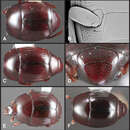Description
provided by Zookeys
Length: 1.50–2.03 mm, width: 1.31–1.78 mm; body rufopiceous, ovoid, widest near middle of elytra; frons depressed at middle; frontal stria rounded at sides, complete or interrupted over antennal bases, arcuate across middle; labrum narrow, less than twice as wide as long, apex asymmetrically emarginate, left side protruding, with small apical process beneath margin; left mandible untoothed, right with small acute basal tooth; pronotal disk without prescutellar impression, disk with very fine, inconspicuous ground punctation, with ~16-20 coarse punctures near sides; marginal pronotal stria complete to narrowly interrupted behind head; submarginal pronotal stria continuous across front, fine, close to margin, and frequently interrupted at sides; elytron with single complete epipleural stria, subhumeral striae absent, stria 1-2 complete, striae 3-4 present basally and apically, but broadly interrupted at middle, 5th stria absent, sutural present in apical two-thirds, continuous apically with strong apical marginal stria; prosternum depressed, with weak basal emargination, carinal striae complete, narrowed between coxae, slightly bulbous anteriorly, with secondary carinal striae in basal half; mesoventral margin very weakly projecting, marginal stria interrupted; mesometaventral stria broadly, subangulately arched forward to near mesoventral margin; lateral metaventral stria extending posterad to middle of metacoxa; 1st abdominal ventrite with single arcuate lateral stria, present in basal two-thirds of ventrite, with detached, transverse postmetacoxal stria which passes through a deep fovea behind posterolateral corner of coxa; ground punctation of pygidia fine, inconspicuous, microsculpture absent; propygidium with moderately large, shallow punctures separated by less than their diameters in basal half, apical half with only few small punctures; pygidium with small punctures sparsely scattered by about 5× their diameters; marginal pygidial stria fine, present along apical half of margin only. Male genitalia (Figs 72E–G, K): accessory sclerites present, very small; T8 short, sides parallel in basal half, angulate and convergent from near midpoint to apex, basal emargination very deep, reaching basal membrane attachment line, apical emargination almost absent, ventrolateral apodemes subacute ventrally, nearly meeting at midline beneath; S8 with sides parallel in basal half, divergent and downturned to subacute apices, apical guides most strongly developed at middle, narrowed to base and apex, ventral halves fused at base, evenly divergent to apices; T9 with sides weakly convergent in basal two-thirds, more strongly convergent to narrow, subacute apices; T10 weakly sclerotized, halves separate; S9 short, wide, with sides mostly parallel, weakly narrowed near apex, apex broadly, angulately emarginate, with apical flange interrupted at middle, basolateral corners prolonged as fine filaments; tegmen more or less parallel-sided in basal two-thirds, narrowed to apex, medioventral process vestigial, barely visible as a narrowly ‘V’-shaped, weakly sclerotized ventral thickening, not at all projecting beneath; tegmen in lateral view constricted at base, evenly and weakly curving to apex; median lobe about two-thirds tegmen length; basal piece about one-fifth tegmen length.
- license
- cc-by-3.0
- copyright
- Michael S. Caterino, Alexey K. Tishechkin
- bibliographic citation
- Caterino M, Tishechkin A (2013) A systematic revision of Operclipygus Marseul (Coleoptera, Histeridae, Exosternini) ZooKeys 271: 1–401
- author
- Michael S. Caterino
- author
- Alexey K. Tishechkin

